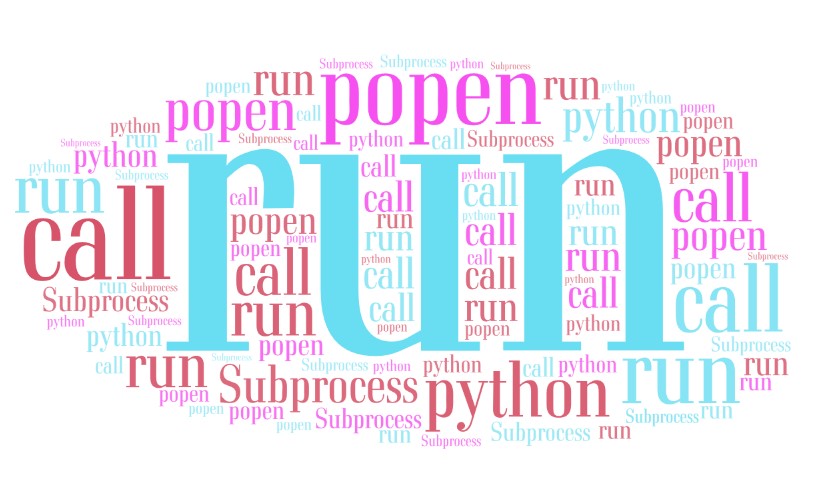Python subprocess
Table of Contents:
- What is subprocess?
- Using
subprocess.call() - Using
subprocess.run() - Using
subprocess.Popen() - Using
check_output() - Using
getoutput() - Run two commands in parallel
- Run arbitrary many commands in parallel
- Another way of parallel execution

What is subprocess?
A subprocess is a child process created by another process that executes a child program concurrently. Passing a string to a subprocess provides input for the subprocess to work with.
To use subprocess module write:
import subprocess
This module allows you to spawn processes, connect to their input/output/error pipes, and obtain their return codes.
Type dir(subprocess) for more details.
Clearly call() and run() and Popen() are the often used methods.
subprocess.call() can run a subprocess and get just the return code.
subprocess.run() is more powerful than call(), it can return the return code, the output and the error.
subprocess.Popen() is even more powerful that run(), it can return whatever run() can and additional items such as process PID.
Using subprocess.call()
This command waits for command to complete or to timeout, then returns the return code.
Example:
import subprocess
subprocess.call(["ls", "-all"])
# returns 0 (success)
Using subprocess.run()
Example:
import subprocess
from subprocess import PIPE
cp = subprocess.run(["ls","-all"], universal_newlines=True, stdout=PIPE, stderr=PIPE)
print(cp.args)
print(cp.returncode)
print(cp.stdout)
print(cp.stderr)
Out:
['ls', '-all']
0
drwxr-xr-x 1 root root 4096 Nov 13 17:33 .
drwxr-xr-x 1 root root 4096 Nov 24 11:51 ..
drwxr-xr-x 1 root root 4096 Nov 13 17:33 tenor
drwxr-xr-x 1 root root 4096 Nov 13 17:33 baritone
drwxr-xr-x 1 root root 4096 Nov 13 17:33 bass
Example: Error
import subprocess
from subprocess import PIPE
cp = subprocess.run(["ls", "soprano" ,"-all"], universal_newlines=True, stdout=PIPE, stderr=PIPE)
print(cp.args)
print(cp.returncode)
print(cp.stdout)
print(cp.stderr)
Out:
['ls', 'soprano', '-all']
2
ls: cannot access 'soprano': No such file or directory
Using subprocess.Popen()
subprocess.Popen() has complex syntax vs. call() and run() but brings more control.
Get the process id of the command
Example: PID
import subprocess
from subprocess import PIPE
p = Popen(["ls","-all"], stdout=PIPE, stderr=PIPE, universal_newlines=True)
pid = p.pid
pid # 313
Get the output and standard error
Example: Output or Error
import subprocess
from subprocess import PIPE
p = Popen(["ls","-all"], stdout=PIPE, stderr=PIPE, universal_newlines=True)
out, err = p.communicate()
print(out, err)
Write out to to a file based on file handle
import subprocess
from subprocess import Popen
from subprocess import PIPE
tmp = '/tmp/tmp.1.txt'
fh = open(tmp,'w+')
p = Popen(["ls","-all"], universal_newlines=True, stdout=fh, stderr=PIPE)
out, err = p.communicate()
print(out, err)
fh.close()
Out:
None
The output is inside the file:
$> cat /tmp/tmp.1.txt
drwxr-xr-x 1 root root 4096 Nov 13 17:33 .
drwxr-xr-x 1 root root 4096 Nov 24 11:51 ..
drwxr-xr-x 1 root root 4096 Nov 13 17:33 tenor
drwxr-xr-x 1 root root 4096 Nov 13 17:33 baritone
drwxr-xr-x 1 root root 4096 Nov 13 17:33 bass
Waiting for the subprocess to finish
By default, calls to Popen() creates a subprocess in the background and don’t wait for it to terminate. You can wait for the subprocess to finish like this:
from subprocess import Popen
p = Popen(["ls","-all"])
p.wait()
Using check_output()
Example:
import subprocess
r = subprocess.check_output(["ls", "-all"], universal_newlines=True)
print(r)
This function can also throw the exception in which case you may use try and except like this:
Example:
try:
result = subprocess.check_output(cmd, shell=True)
print(result)
except subprocess.CalledProcessError as error:
print(error)
This method returns only the output, check the next method that works for both output and error.
Using getoutput()
This method returns both the output in case no error and the error in case of error.
Example: Returns the output
import subprocess
r = subprocess.getoutput('ls -all')
print(r)
Out:
drwxr-xr-x 1 root root 4096 Nov 13 17:33 .
drwxr-xr-x 1 root root 4096 Nov 24 11:51 ..
drwxr-xr-x 1 root root 4096 Nov 13 17:33 tenor
drwxr-xr-x 1 root root 4096 Nov 13 17:33 baritone
drwxr-xr-x 1 root root 4096 Nov 13 17:33 bass
Example: Returns the error in case of error
import subprocess
r = subprocess.getoutput('ls soprano -all')
print(r)
Out:
ls: cannot access 'soprano': No such file or directory
Run two commands in parallel
from subprocess import Popen
commands = ['command1', 'command2']
procs = [ Popen(i) for i in commands ]
for p in procs:
p.wait()
Run arbitrary many commands in parallel
%%time
from subprocess import Popen
from subprocess import PIPE
cmds_list = []
for s in range(100):
cmds_list.append(['sleep', str(2)])
procs_list = [Popen(cmd, stdout=PIPE, stderr=PIPE) for cmd in cmds_list]
for proc in procs_list:
proc.wait()
Out:
CPU times: user 60.3 ms, sys: 303 ms, total: 363 ms
Wall time: 2.63 s
In here we executed the command sleep 2 for 100 times and that took 2.63 seconds.
This means running the commands with Popen() is asynchronous.
Another way of parallel execution
from concurrent.futures import ThreadPoolExecutor
import time
def exec_(cmd):
'''
single command run
command must be prepared as subprocess.call
'''
ret = subprocess.call(cmd)
if ret== 0:
print("success...")
else:
print("error")
def pull_run(parallel_jobs, cmds):
'''
run pull of jobs
input:
parallel_jobs: integer, how many jobs at once
cmds: list of commands
'''
with ThreadPoolExecutor(max_workers=parallel_jobs) as executor:
futures = executor.map(exec_, cmds)
We will run 10 times sleep 2 but the max number of parallel jobs will be 4.
%%time
cmds = [['sleep', '2'] for i in range(10)]
pull_run(4, cmds)
Out:
success...
success...
success...
success...
success...
success...
success...
success...
success...
success...
CPU times: user 19.4 ms, sys: 57.5 ms, total: 76.8 ms
Wall time: 6.07 s
…
tags: subprocess & category: python
